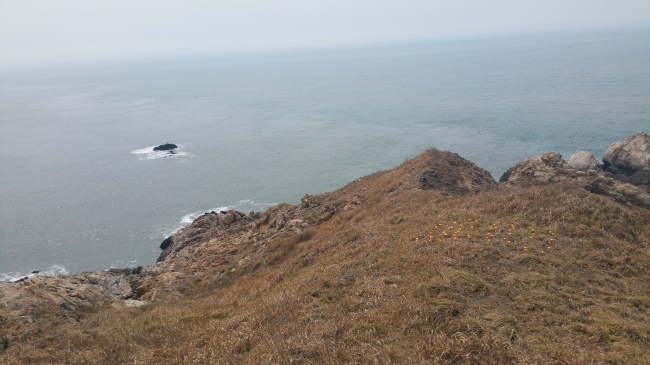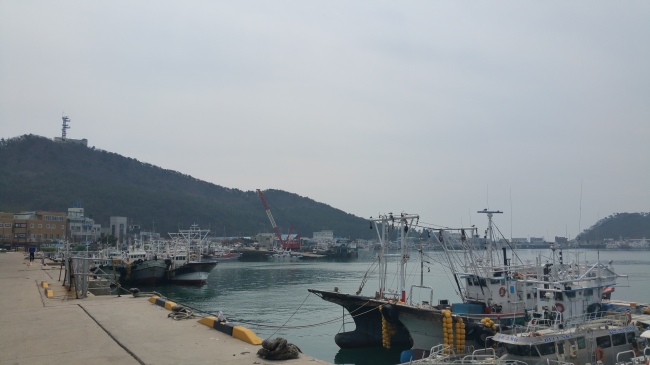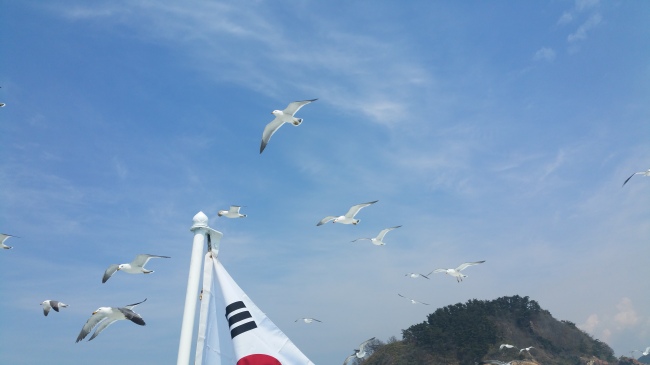The West Sea is famous for islands scattered across the coast, like breadcrumbs enticing seagulls. The 114 islands off the coast of Taean-gun, South Chungcheong Province, are a typical example. Featuring a natural habitat that has remained free from human touch for the most part, each island boasts its own unique characteristics.
There is no train connection, so visitors have to either drive or take a bus to the coastal town. If you are traveling from Seoul, buses are available at the Central City Terminal or Seoul Nambu Bus Terminal, both in Seocho-gu, southern Seoul. In both cases, the bus duration is one-two hours apart, with the first bus to Taean leaving from Nambu at 6:40 a.m. and from Central City at 7:10 a.m. The last one leaves around 8 p.m.
Kick back, relax, and if the traffic isn’t too bad, you will arrive at the seaside town in a little over two hours.
Ongdo and Nando
The Taean Beach has a rugged and rough feel to it, as cries of the black-tailed gull welcome outsiders.
If you want to visit the islands, you should head for Sinjindo, which is connected by road to the mainland. There is also a ferry service, called Anheung Yuramseon (pronounced An-hung-yoo-ram-sun,) linking Sinjindo and Ongdo from 11 a.m. to 2 p.m. on weekends. On weekdays, the ferry leaves for Ongdo only once a day at 2 p.m.
You can make inquiries at 041-674-1603, but it is only in Korean. The ferry does not sail during winter -- usually from January to April.
Before you set off, you could try the delicacies of the region such as the blue crab and other fresh seafood. According to Park Eun-seo, a former ship captain who now works as a guide, the seafood is “chewier because the fast current makes the marine life more muscular.”
After setting sail, it takes about 30 minutes to get to Ongdo, which gets its name for looking like an upside-down pot (“ong” in Korean). The island is home to the only manned lighthouse in the region since 1907.
There is no train connection, so visitors have to either drive or take a bus to the coastal town. If you are traveling from Seoul, buses are available at the Central City Terminal or Seoul Nambu Bus Terminal, both in Seocho-gu, southern Seoul. In both cases, the bus duration is one-two hours apart, with the first bus to Taean leaving from Nambu at 6:40 a.m. and from Central City at 7:10 a.m. The last one leaves around 8 p.m.
Kick back, relax, and if the traffic isn’t too bad, you will arrive at the seaside town in a little over two hours.
Ongdo and Nando
The Taean Beach has a rugged and rough feel to it, as cries of the black-tailed gull welcome outsiders.
If you want to visit the islands, you should head for Sinjindo, which is connected by road to the mainland. There is also a ferry service, called Anheung Yuramseon (pronounced An-hung-yoo-ram-sun,) linking Sinjindo and Ongdo from 11 a.m. to 2 p.m. on weekends. On weekdays, the ferry leaves for Ongdo only once a day at 2 p.m.
You can make inquiries at 041-674-1603, but it is only in Korean. The ferry does not sail during winter -- usually from January to April.
Before you set off, you could try the delicacies of the region such as the blue crab and other fresh seafood. According to Park Eun-seo, a former ship captain who now works as a guide, the seafood is “chewier because the fast current makes the marine life more muscular.”
After setting sail, it takes about 30 minutes to get to Ongdo, which gets its name for looking like an upside-down pot (“ong” in Korean). The island is home to the only manned lighthouse in the region since 1907.

When on Ongdo, I would recommend finding a deserted spot looking at the sea. Sitting all alone, while listening to the gentle bustle of dry grass, waves slapping the surface with the horizon extending as far as the eye brings serenity, something I honestly did not expect and enjoyed.
Unfortunately, the skies were gray during my visit to the island, but Park said the waters are emerald green under clear skies. “That was what drew me to the sea,” she said, recommending that it is best to visit from May to October.
She added that sometimes on a clear day, mirages creep up on unsuspecting passengers while her ferry would pass by the rocky islands.

A ferry ride out of Ongdo takes about an hour because it passes by other islands in the area, all of which are uninhabited except Gauido, famous for garlics.
But what was most impressive was something that wasn’t even on the menu. The official ferry doesn’t go near Nando in order to preserve its natural habitat, but an occasional sail-by via a fishing boat can provide some spectacular sights.
Nando’s location and rocky surface has made it unapproachable, and its lack of predators like hawks have made it a safe haven for the black-tailed gull. From a distance, it looks like the island is covered with white specks, before you realize that they all have wings.

When approached, the school of gulls began to fly around the ship looking for food. It was truly a sight to behold but the county officials said they have no plans to make it a tourist attraction, as constant visits by tourists may be harmful for the birds.
Relics from the depths
Not far from Ongdo is Mado, where ships from Goryeo Kingdom (918~1392) and Joseon era (1392~1910) were salvaged, along with relics that offer hints of what the life back then were like.
In 2007, a Goryeo-Kingdom sunken ship carrying thousands of valuable celadon vases were salvaged off the coast of Taean, alerting the rest of the country of the potential values hiding in the region. Since then, around 30,000 pieces of relics have been recovered in the area.
These relics are displayed in Taean National Maritime Museum, slated for official opening in mid-November. As of now, 170 pieces of relics are on display at two halls as pre-open exhibitions.
One of them is exhibition “Treasure of Goryeo Found Under the Sea,” which displays the cargo found on ancient ships along with a section explaining what it was like to sail and live on these vessels. It will continue until Aug. 18.
The museum officials are planning to hold another exhibition around late August.
Another exhibition displaying the relics and a section showing how they are recovered from within the depths will be open until the official opening of the museum.
Other places to visit
Anmyeondo Island and Kkotji Beach are some of the most well-known attractions in Taean area. But another place also worth visiting is the Chollipo Arboretum.
Located on the tip of the peninsula, it was founded by naturalized Korean Carl Ferris Miller. It is not only home to plant life that are indigenous to the central part of the Korean Peninsula, but also its southern parts, boasting a total of 15,800 kinds of plants.
Among its main attractions is Miller Garden, which has used minimal pruning or use of chemical fertilizers to provide natural habitat for the botanical garden. It is also located right next to the sea, providing a view of the West Sea for those looking to enjoy a stroll.
The arboretum also provides accommodations, some of which are styled like traditional Korean houses.
For more information in Korean or English, visit http://www.chollipo.org/eng.
By Yoon Min-sik (minsikyoon@heraldcorp.com)










![[Kim Seong-kon] Democracy and the future of South Korea](http://res.heraldm.com/phpwas/restmb_idxmake.php?idx=644&simg=/content/image/2024/04/16/20240416050802_0.jpg&u=)








![[Today’s K-pop] BTS pop-up event to come to Seoul](http://res.heraldm.com/phpwas/restmb_idxmake.php?idx=642&simg=/content/image/2024/04/17/20240417050734_0.jpg&u=)